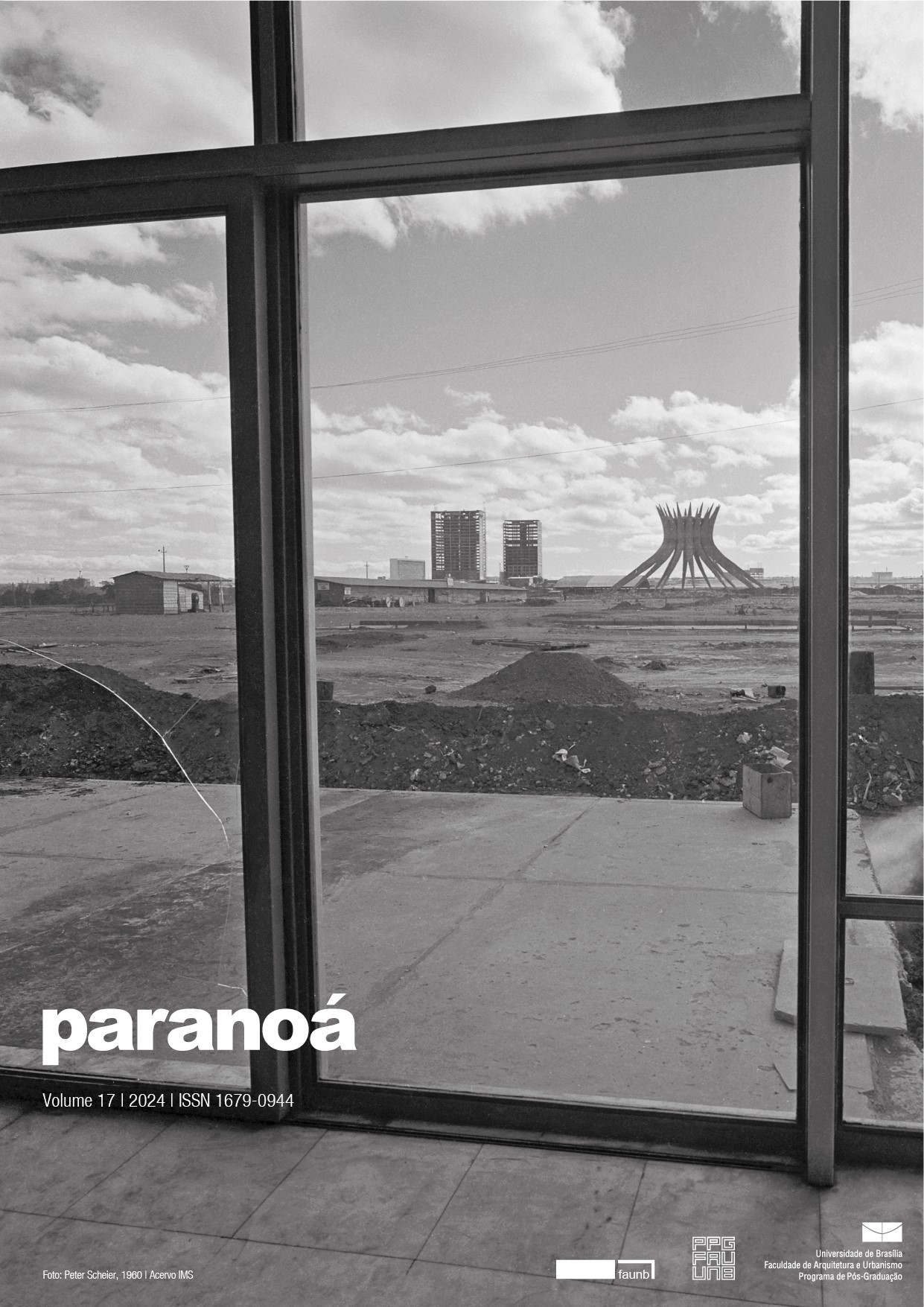Daylighting perception in residential spaces according to users
DOI:
https://doi.org/10.18830/1679-09442024v17e48391Keywords:
Daylighting, Environmental perception, Design quality, StandardizationAbstract
In Brazil, both NBR 15.575:2013 and NBR 15.215:2005 are in the process of being revised, including new evaluation indexes related to human preferences. Thus, this study aimed to understand the perception of occupants in the use of residential space to support eventual normatization indications. The methodology consisted of conducting an on-line questionnaire, applied in 2020, with 542 valid responses from all over the country. The Likert scale was used to analyze the results. The results showed that residences located in dense regions had the worst weighted averages in the evaluation of the quality of daylight and that the presence of larger openings for lighting, in turn, generated better results. In the kitchens, it was found that the indirect lighting by the service area, as well as the kitchen layout affect the perception of the availability of daylight of the space, this being the second environment indicated as being of higher priority for good daylighting. It was also found that there is a demand for better daylighting of the bathrooms. Generally speaking, the results reveal a correlation between factors that influence the daylight availability and the perception of users, and its consideration is considered of paramount importance for the adequate definition of metrics of the Brazilian regulations.
Downloads
References
ABNT, ASSOCIAÇÃO BRASILEIRA DE NORMAS TÉCNICAS. Proposta de revisão da NBR 15215-3: Procedimento de cálculo para a determinação da iluminação natural em ambientes internos (Versão 19). Rio de Janeiro, 2023.
ABNT, ASSOCIAÇÃO BRASILEIRA DE NORMAS TÉCNICAS. Proposta para reestruturação do item 13 - Desempenho lumínico da 1 norma NBR 15.575. Rio de Janeiro, 2020.
AMORIM, C. N. D.; VASQUEZ, N. G.; MATUSIAK, B.; KANNO, J.; SOKOL, N.; MARTYNIUK-PECZEK, J.; SIBILIO, S.; KOGA, Y.; CIAMPI, G.; WACZYNSKA, M. Lightning in conditions in home office and occupant’s perception: An international study. Energy and Buildings, v. 261, 2022. DOI: https://doi.org/10.1016/j.enbuild.2022.111957.
BALVEDI, B. F.; GHISI, E.; LAMBERTS, R. A review of occupant behaviour in residential buildings, Energy and Buildings, v 174, pp 495-505, 2018. DOI: https://doi.org/10.1016/j.enbuild.2018.06.049.
CEN, EUROPEAN COMMITTEE FOR STANDARDIZATION. EN 12665: Light and lighting - Basic terms and criteria for specifying lighting requirements. Belgium, 2018a.
CEN, EUROPEAN COMMITTEE FOR STANDARDIZATION. EN 17037: Daylight in buildings. Belgium, 2018b.
CNS, CONSELHO NACIONAL DE SAÚDE, Resolução n° 510 de 7 de abril de 2016. Resolução sobre normas aplicáveis a pesquisa em Ciências Humanas e Sociais. Ministério da Saúde, Brasil, 2016. Disponível em: https://bvsms.saude.gov.br/bvs/saudelegis/cns/2016/res0510_07_04_2016.html. Acesso em: 09/01/2024.
ERIKSSON, S.; WALDENSTRON, L.; TILLBERG, M.; OSTERBRING, M.; KALAGASIDIS, A. S., Numerical simulations and empirical data for the evaluation of daylight factors in existing buildings in Sweden. Energies, v12 (11), 2019. DOI: https://doi.org/10.3390/en12112200
FLEMING, D.; GRIMES, A.; LEBRETON, L.; MARÉ, D.; NUNNS. P. Valuing sunshine. Regional Science and Urban Economics, v. 68, pp. 268-276, 2018. DOI: https://doi.org/10.1016/j.regsciurbeco.2017.11.008.
IBGE, INSTITUTO BRASILEIRO DE GEOGRAFIA E ESTATÍSTICA. Mapa de densidade demográfica. Disponível em: <https://geoftp.ibge.gov.br/cartas_e_mapas/mapas_do_brasil/sociedade_e_economia/mapas_murais/densidade_populacional_2010.pdf>. Acesso em: 30 nov. 2021.
JAMROZIK, A.; CLEMENTS, N.; HASAN, S. S.; ZHAO, J.; ZHANG, R.; CAMPANELLA, C.; LOFTNESS, P. P.; LY, S.; WANG, S.; BAUER, B. Access to daylight and view in an office improves cognitive performance and satisfaction and reduces eyestrain: A controlled crossover study. Building and Environment, v. 165, 019. DOI: https://doi.org/10.1016/j.buildenv.2019.106379.
LEDER, S. M; PEREIRA, F. O. R. Ocupação urbana e disponibilidade de luz natural. Revista Minerva, v. 5, p. 129-138, 2008.
LUNDGREN, B. Custom-perceived Value in Residential Developments: The Case of Hornsberg Strand, Sweden. International Real Estate Review, v. 16, pp. 1 - 27, 2013.
MORALES-BRAVO, J.; NAVARRETE-HERNANDEZ, P. Enlightening wellbeing in the home: The impact of natural light design on perceived happiness and sadness in residential spaces. Building and Environment, v. 223, 2022. DOI: https://doi.org/10.1016/j.buildenv.2022.109317.
PENG XUE, C. M. M.; CHEUNG, H. D. The effects of daylighting and human behavior on luminous comfort in residential buildings: A questionnaire survey. Building and Environment, v 81, pp 51-59, Elsevier, 2014. Doi: https://doi.org/10.1016/j.buildenv.2014.06.011
SANTIAGO, I.; MORENO-MUNOZ, A.; QUINTERO-JIMÉNEZ, P.; GARCIA-TORRES, F.; GONZALEZ-REDONDO, M. J. Electricity demand during pandemic times: the case of the COVID-19 in Spain. Energy Policy, v. 148, part A, Jan. 2021. DOI: https://doi.org/10.1016/j.enpol.2020.111964.
SEO, J.; CHOI, A.; SUNG, M. Recommendation of indoor luminous environment for occupants using big data analysis based on machine learning. Building and Environment, v. 198, 2021. DOI: https://doi.org/10.1016/j.buildenv.2021.107835.
TECHIO, L. M.; ZAMBONATO, B.; GRIGOLETTI, G. de C.; CLARO, A. Iluminação natural em habitação multifamiliar: o caso do conjunto residencial videiras, Santa Maria, RS. PARC, Campinas, SP, v. 12, n. 00, p. e021007, 2021. DOI: 10.20396/parc.v12i00.8659780. Disponível em: https://periodicos.sbu.unicamp.br/ojs/index.php/parc/article/view/8659780.
WANG, C.; ZHANG, F.; WANG, J.; DOYLE, J. K.; HANCOCK, P. A.; MAK, C. M.; LIU, S. How indoor environmental quality affects occupants’ cognitive functions: A systematic review. Building and Environment, v. 193, 2021. DOI: https://doi.org/10.1016/j.buildenv.2021.107647.
Downloads
Published
How to Cite
Issue
Section
License
Copyright (c) 2024 Paranoá

This work is licensed under a Creative Commons Attribution 4.0 International License.
Autores que publicam nesta revista concordam com os seguintes termos:
- Autores mantém os direitos autorais e concedem à revista o direito de primeira publicação, com o trabalho simultaneamente licenciado sob a Licença Creative Commons Attribution que permite o compartilhamento do trabalho com reconhecimento da autoria e publicação inicial nesta revista. http://creativecommons.org/licenses/by/4.0
- Autores têm autorização para assumir contratos adicionais separadamente, para distribuição não-exclusiva da versão do trabalho publicada nesta revista (ex.: publicar em repositório institucional ou como capítulo de livro), com reconhecimento de autoria e publicação inicial nesta revista.
- Autores têm permissão e são estimulados a publicar e distribuir seu trabalho online (ex.: em repositórios institucionais ou na sua página pessoal) a qualquer ponto antes ou durante o processo editorial, já que isso pode gerar alterações produtivas, bem como aumentar o impacto e a citação do trabalho publicado (Veja O Efeito do Acesso Livre).















